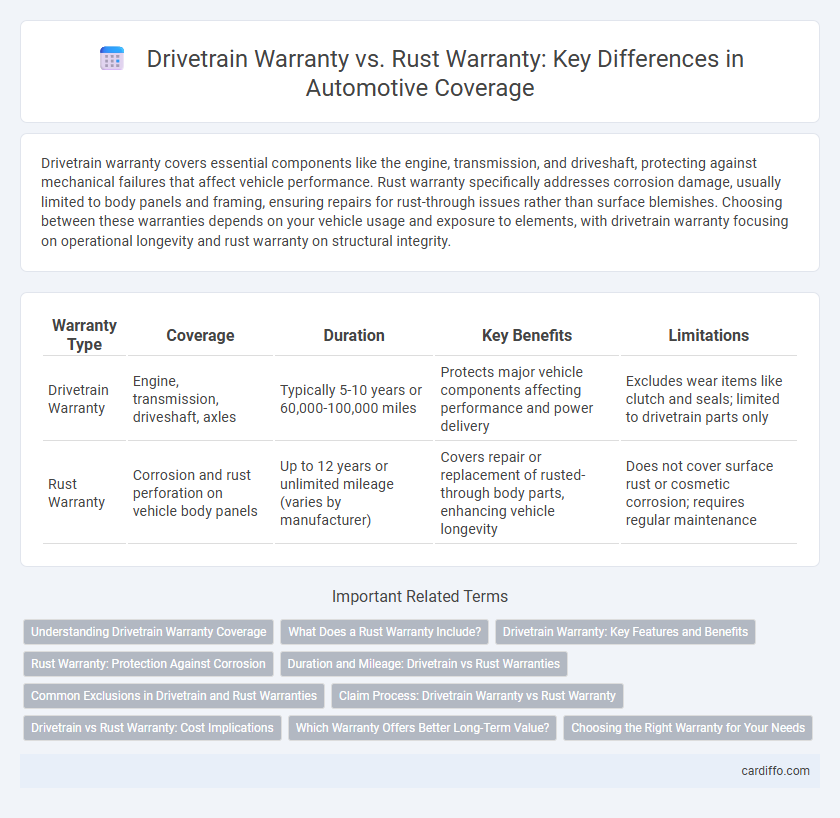Drivetrain warranty covers essential components like the engine, transmission, and driveshaft, protecting against mechanical failures that affect vehicle performance. Rust warranty specifically addresses corrosion damage, usually limited to body panels and framing, ensuring repairs for rust-through issues rather than surface blemishes. Choosing between these warranties depends on your vehicle usage and exposure to elements, with drivetrain warranty focusing on operational longevity and rust warranty on structural integrity.
Table of Comparison
| Warranty Type | Coverage | Duration | Key Benefits | Limitations |
|---|---|---|---|---|
| Drivetrain Warranty | Engine, transmission, driveshaft, axles | Typically 5-10 years or 60,000-100,000 miles | Protects major vehicle components affecting performance and power delivery | Excludes wear items like clutch and seals; limited to drivetrain parts only |
| Rust Warranty | Corrosion and rust perforation on vehicle body panels | Up to 12 years or unlimited mileage (varies by manufacturer) | Covers repair or replacement of rusted-through body parts, enhancing vehicle longevity | Does not cover surface rust or cosmetic corrosion; requires regular maintenance |
Understanding Drivetrain Warranty Coverage
Drivetrain warranty coverage primarily protects essential components such as the engine, transmission, and driveshaft, ensuring repairs or replacements are covered if these parts fail due to manufacturing defects. Unlike rust warranties, which specifically cover corrosion and perforation of the vehicle's body panels over a set period, drivetrain warranties focus on the mechanical integrity and performance of the powertrain system. Understanding the terms, duration, and exclusions of a drivetrain warranty helps vehicle owners maximize their protection against costly mechanical failures.
What Does a Rust Warranty Include?
A Rust Warranty typically covers corrosion damage that affects the vehicle's body panels and structural components due to rust-through rather than surface rust or cosmetic blemishes. This warranty usually includes repairs or replacement of metal parts that have deteriorated because of rust perforation, ensuring protection against extensive body damage. Unlike a Drivetrain Warranty, which focuses on engine, transmission, and drivetrain components, a Rust Warranty addresses the integrity of the vehicle's exterior and frame against corrosive damage.
Drivetrain Warranty: Key Features and Benefits
Drivetrain warranty covers critical components like the engine, transmission, and driveshaft, ensuring protection against mechanical failures that affect vehicle performance. This warranty typically offers extended coverage periods and higher repair cost limits compared to rust warranty, providing substantial financial relief for major repairs. Owners benefit from increased vehicle reliability and resale value, as drivetrain issues are among the most costly and impactful to address.
Rust Warranty: Protection Against Corrosion
Rust Warranty offers essential protection against corrosion, covering body panels and structural components susceptible to rust damage over time. Unlike Drivetrain Warranty, which primarily safeguards engine, transmission, and related mechanical parts, Rust Warranty ensures that the vehicle's exterior and undercarriage maintain integrity against environmental factors like moisture and salt. This coverage is crucial for extending the lifespan and preserving the resale value of vehicles in regions prone to harsh weather conditions.
Duration and Mileage: Drivetrain vs Rust Warranties
Drivetrain warranties typically cover essential components like the engine, transmission, and differential for 5 to 10 years or 60,000 to 100,000 miles, offering extensive protection against mechanical failure. Rust warranties focus on the vehicle's body panels and frame, often lasting 5 to 12 years with unlimited mileage, emphasizing protection against corrosion and perforation. Understanding the differences in duration and mileage limits between drivetrain and rust warranties helps consumers select coverage that matches their driving habits and long-term vehicle care needs.
Common Exclusions in Drivetrain and Rust Warranties
Drivetrain warranties commonly exclude coverage for wear and tear components like clutch assemblies, seals, and gaskets, as well as damages caused by neglect, improper maintenance, or modifications. Rust warranties typically exclude surface rust, damage from environmental factors such as road salt or acid rain, and corrosion resulting from accidents or improper repairs. Both warranties generally require adherence to manufacturer maintenance schedules to remain valid and exclude damages caused by misuse or unauthorized alterations.
Claim Process: Drivetrain Warranty vs Rust Warranty
The claim process for a drivetrain warranty typically involves presenting proof of regular maintenance and detailed repair records to verify mechanical failures covered under the warranty. Rust warranty claims require documentation showing rust corrosion beyond surface level, often confirmed through a professional inspection or photographic evidence. Both warranties necessitate timely claims submission within the specified coverage period to ensure eligibility and avoid denial.
Drivetrain vs Rust Warranty: Cost Implications
Drivetrain warranties typically cover critical components such as the engine, transmission, and drivetrain systems, often resulting in higher repair costs but providing extensive mechanical protection. Rust warranties focus on corrosion and body panel damage caused by rust, generally involving less expensive repairs but with a narrower scope of coverage. Evaluating cost implications, drivetrain warranty claims tend to be more costly but crucial for expensive mechanical failures, while rust warranties offer affordability yet limited financial protection for structural integrity issues.
Which Warranty Offers Better Long-Term Value?
Drivetrain warranties typically offer better long-term value by covering essential components like the engine, transmission, and axles, which are expensive to repair and critical to vehicle operation. Rust warranties focus on corrosion protection, usually for the vehicle's body panels, and while important, rust damage generally occurs over a longer term and is often less costly than drivetrain repairs. Investing in a comprehensive drivetrain warranty often ensures greater financial protection against major mechanical failures, providing more immediate and significant savings.
Choosing the Right Warranty for Your Needs
Selecting the right warranty depends on your vehicle's usage and environment; drivetrain warranties cover essential components like the transmission and engine, ensuring costly repairs are protected. Rust warranties specifically address corrosion issues, ideal for regions with harsh winters or coastal climates where salt and moisture accelerate rust. Evaluate your driving habits, climate exposure, and long-term vehicle ownership plans to determine whether a drivetrain or rust warranty best safeguards your investment.
Drivetrain Warranty vs Rust Warranty Infographic

 cardiffo.com
cardiffo.com